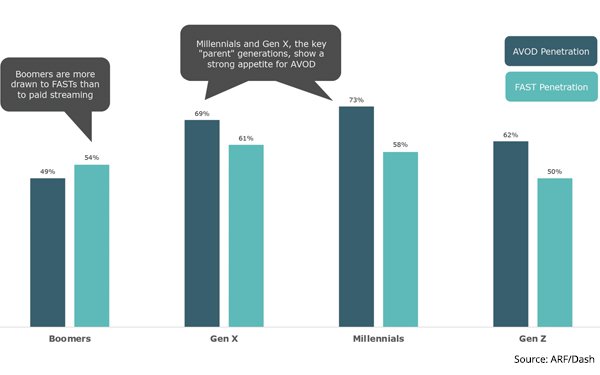
Young and older U.S. consumers continue to show diverging
preferences when it comes to legacy and new TV-video platforms, according to ARF’s DASH, a syndicated study conducted in partnership with the National Opinion Research Center at the University
of Chicago.
Platform penetration usage of TV “boomer” consumers -- those born in the late 1940s through late 1950s -- show this group was more drawn to FAST channels (54%) than to
paid AVOD (49%).
FAST are (free ad-supported/streaming TV) channels, while AVOD are paid subscription/advertising-supported streaming platforms.
Authors of the report suggest that FAST
are familiar channels for boomers, especially when it comes to channel-surfing of legacy TV. In addition, FAST channels feature a lot of library programming services they are accustomed to.
Other younger demographic groups all give higher performance to AVOD. But FAST also gets good results.
advertisement
advertisement
After boomers, the next-oldest generation -- Gen Xers, those born from around 1960
through 1980 -- have a 69% preference for AVOD, as well as a 61% affinity for FASTs. Younger millennials come in at 73% for AVOD, with 58% for FASTs.
Gen Z consumers -- who spend less time on
TV than other groups -- have 62% AVOD platform penetration, compared to 50% for FAST.
By comparison, only 36% of Gen Zers watch two or more hours of TV sets per day, and 73% of boomers.
Watching TV shows on smart devices? Gen Z scores 34%, versus 7% for boomers.
“In short, younger generations aren’t just choosing new platforms,” write the authors of the
study. “Their emphasis on flexibility, convenience, and personalization is reshaping how TV fits into their lives.”
This all suggests that younger generations -- while they are
looking to avoid advertising -- will still use the platforms when “the value is clear" -- which means avoiding AVOD isn’t a good idea.
Brands in categories like consumer
packaged goods (CPG), family entertainment and financial services will miss core consumers.
The most recent full-year DASH study in 2024, was conducted online, face-to-face and by phone among
10,122 U.S. adults.